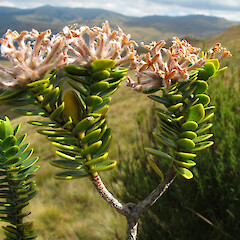Pimelea poppelwellii
Common name
Poppelwell’s pimelea
Synonyms
None
Family
Thymelaeaceae
Flora category
Vascular – Native
Endemic taxon
Yes
Endemic genus
No
Endemic family
No
Structural class
Trees & Shrubs - Dicotyledons
NVS code
The National Vegetation Survey (NVS) Databank is a physical archive and electronic databank containing records of over 94,000 vegetation survey plots - including data from over 19,000 permanent plots. NVS maintains a standard set of species code abbreviations that correspond to standard scientific plant names from the Ngä Tipu o Aotearoa - New Zealand Plants database.
PIMPOP
Current conservation status
The conservation status of all known New Zealand vascular plant taxa at the rank of species and below were reassessed in 2017 using the New Zealand Threat Classification System (NZTCS) – more information about this can be found on the NZTCS website. This report includes a statistical summary and brief notes on changes since 2012 and replaces all previous NZTCS lists for vascular plants.
Please note, threat classifications are often suggested by authors when publications fall between NZTCS assessment periods – an interim threat classification status has not been assessed by the NZTCS panel.
- Conservation status of New Zealand indigenous vascular plants, 2017 . 2018. Peter J. de Lange, Jeremy R. Rolfe, John W. Barkla, Shannel P. Courtney, Paul D. Champion, Leon R. Perrie, Sarah M. Beadel, Kerry A. Ford, Ilse Breitwieser, Ines Schönberger, Rowan Hindmarsh-Walls, Peter B. Heenan and Kate Ladley. Department of Conservation. Source: NZTCS and licensed by DOC for reuse under the Creative Commons Attribution 4.0 International licence.
2017 | At Risk – Naturally Uncommon | Qualifiers: DP, RR, Sp
Previous conservation statuses
2012 | At Risk – Naturally Uncommon | Qualifiers: RR
2009 | At Risk – Naturally Uncommon | Qualifiers: DP
2004 | Sparse
Brief description
Shrub to 80cm tall with reddish twigs bearing pairs of fleshy bright green pointed leaves with a ridge on the underside and hairy white flowers inhabiting the vicinity of the Garvie Ranges, Eyre Mountains and Hump Ridge. Leaves 6-10mm long by 4-6mm wide. Flowers to 9mm long. Fruit dry.
Distribution
Endemic. South Island, Central Otago and northern Southland. Mainly recorded from the Garvie Range.
Habitat
Subalpine to alpine, often extending to lower elevations in distributed habitats. A species of Snow tussock (Chionochloa spp.) grassland with herbs, and also of low shrubland and rocky sites.
Detailed description
Erect much-branched shrub up to 1 m or more tall. All parts except leaf-axils glabrous; branches stout, bark dark red-brown. Leaves close-set, subimbricate, on stout, fleshy petioles up to 1 mm long; lamina erect to subpatent, 6-10 x 4-6 mm, dark green, paler below and more or less keeled, broad-ovate to ovate-oblong, apex obtuse to subacute, abruptly narrowed at base; firmly fleshy, thick and coriaceous; margins distinctly though slightly thickened. Subfloral leaves distinctly membranous and broader than other leaves. Inflorescence in 5-16-flowered heads. Perianth white or pale rose, densely silky-hairy; tube 6-9 mm long, lobes 2-3 mm long, ovate-oblong to oblong. Fruit 2 mm long, ovoid, dark brown to black, hairy at apex.
Similar taxa
Morphologically perhaps closest to P. traversii which it closely resembles except that it has red-brown rather than dark-brown to almost black bark, and the leaves are petiolate and close-set to subimbricate rather than quadrifariously imbricating and sessile.
Flowering
November – March
Flower colours
Red/Pink, White
Fruiting
January – May
Life cycle
Dry achenes are dispersed by wind and possibly ants (Thorsen et al., 2009).
Propagation technique
Not known in cultivation. Probably easy from cuttings but difficult to maintain like so many New Zealand Pimelea.
Threats
Rather poorly known so its exact distribution is unclear and further field work is needed
Etymology
pimelea: Pimeleoides means “resembling Pimelea’’, a genus in the family Thymelaeaceae (Greek, -oides = resembling, like).
poppelwellii: After Poppelwell
Where To Buy
Not commercially available
Attribution
Fact Sheet prepared for NZPCN by P.J. de Lange 1 August 2003. Description modified from Allan (1961) but see also Burrows (2008).
References and further reading
Allan, H.H. 1961: Flora of New Zealand. Vol. I. Government Printer, Wellington.
Thorsen, M. J.; Dickinson, K. J. M.; Seddon, P. J. 2009. Seed dispersal systems in the New Zealand flora. Perspectives in Plant Ecology, Evolution and Systematics 11: 285-309
NZPCN Fact Sheet citation
Please cite as: de Lange, P.J. (Year at time of access): Pimelea poppelwellii Fact Sheet (content continuously updated). New Zealand Plant Conservation Network. https://www.nzpcn.org.nz/flora/species/pimelea-poppelwellii/ (Date website was queried)


